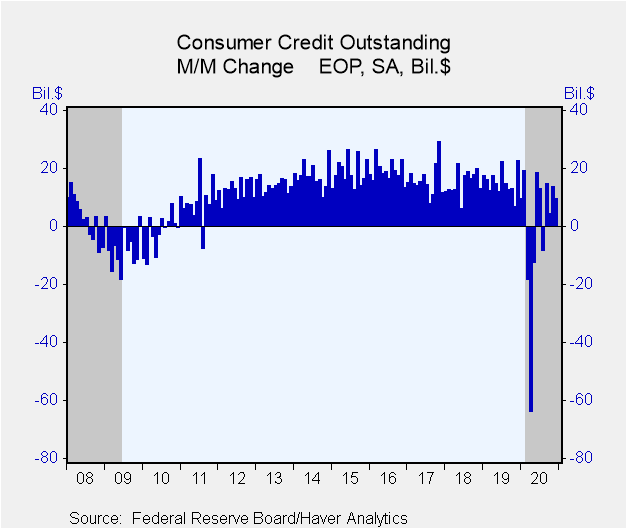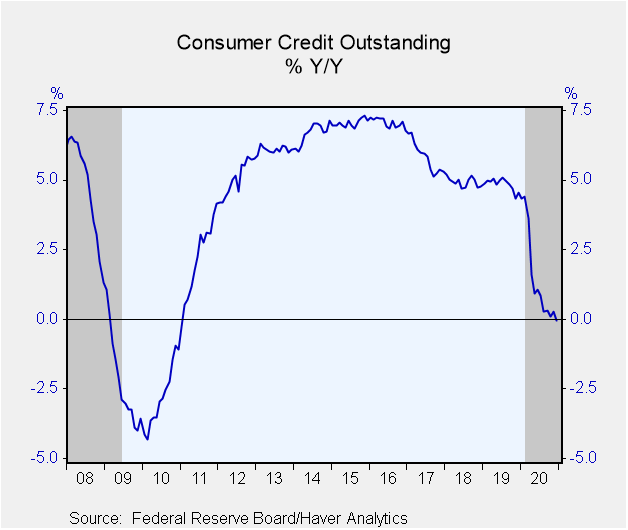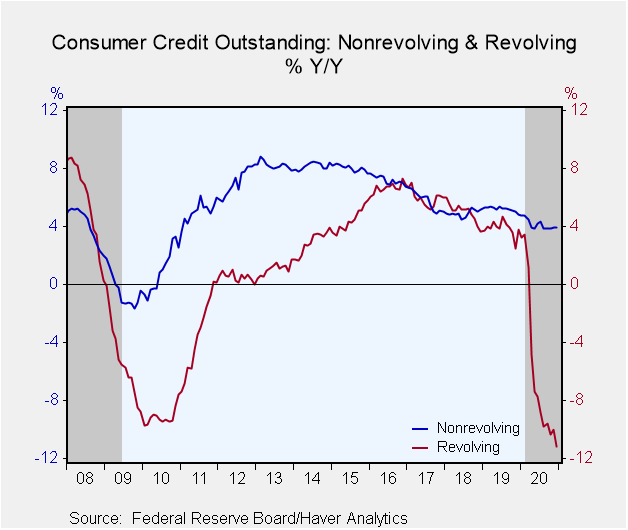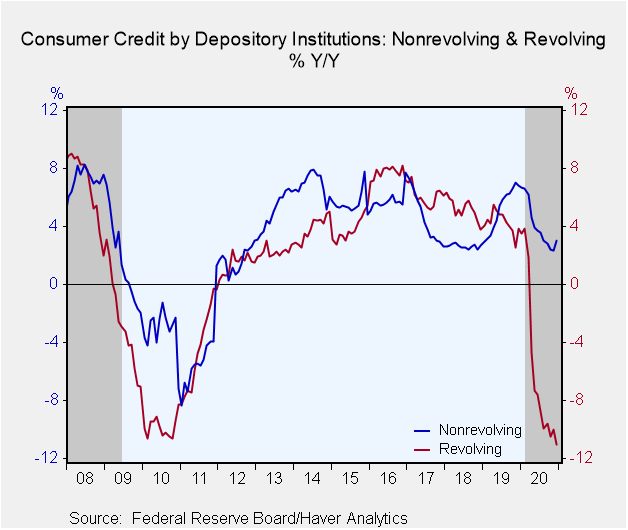 Global| Feb 05 2021
Global| Feb 05 2021U.S. Consumer Credit Growth Slackens During December and in 2020 Overall
by:Tom Moeller
|in:Economy in Brief
Summary
• Credit card financing has been falling sharply. • Nonrevolving credit usage is slowing. Consumers continue to strengthen their balance sheets. Consumer credit outstanding rose a seasonally adjusted& $9.7 billion (-0.0% y/y) during [...]
• Credit card financing has been falling sharply.
• Nonrevolving credit usage is slowing.
Consumers continue to strengthen their balance sheets. Consumer credit outstanding rose a seasonally adjusted& $9.7 billion (-0.0% y/y) during December following a $13.9 billion November increase, revised from $15.3 billion. A $13.0 billion rise had been expected in the Action Economics Forecast Survey. The ratio of consumer credit outstanding-to-disposable personal income fell to 23.9% in 2020, an eight year year low, from 25.6% in 2019.
Revolving consumer credit balances eased $3.0 billion (-11.2% y/y) following a $0.7 billion November slip, revised from $-0.8 billion. They have been falling for just under a year. Credit provided by depository institutions (90% of the total and mostly credit card debt), dropped 11.0% y/y. Credit union borrowing fell 7.6% y/y and finance company loans fell 21.9% y/y.
Nonrevolving credit usage increased $12.7 billion (3.9% y/y) after a $14.6 billion November improvement, revised from $16.1 billion. Federal government borrowing, which issues over 40% of nonrevolving credit, grew 4.8% y/y. Depository institution loans (29% of credit) grew a greatly lessened 3.0% y/y, down from 6.8% y/y growth as of December 2019. Finance company borrowing (16.0% of loans) firmed 3.6% y/y and credit union loans (14.0% of the total) increased 4.3% y/y, versus double-digit growth in each year from 2014 to 2018.
Growth in student loans outstanding fell to 3.7% y/y from double-digit increases as of 2011. Growth in motor vehicle loans was fairly steady at 3.5% y/y.
These Federal Reserve Board figures are break-adjusted and calculated by Haver Analytics. The breaks in the series in 2005, 2010 and 2015 are the result of the incorporation of the Census and Survey of Finance Companies, as well as changes in the seasonal adjustment methodology.
The consumer credit data are available in Haver's USECON database. The Action Economics figures are contained in the AS1REPNA database.
| Consumer Credit Outstanding (M/M Chg, SA) | Dec | Nov | Oct | Dec y/y | 2020 | 2019 | 2018 |
|---|---|---|---|---|---|---|---|
| Total ($ bil) | 9.7 | 13.9 | 4.3 | -0.0% | -0.0% | 4.6% | 4.8% |
| Nonrevolving | 12.7 | 14.6 | 9.8 | 3.9 | 3.9 | 4.9 | 5.2 |
| Revolving | -3.0 | -0.7 | -5.5 | -11.2 | -11.2 | 3.8 | 3.6 |
Tom Moeller
AuthorMore in Author Profile »Prior to joining Haver Analytics in 2000, Mr. Moeller worked as the Economist at Chancellor Capital Management from 1985 to 1999. There, he developed comprehensive economic forecasts and interpreted economic data for equity and fixed income portfolio managers. Also at Chancellor, Mr. Moeller worked as an equity analyst and was responsible for researching and rating companies in the economically sensitive automobile and housing industries for investment in Chancellor’s equity portfolio. Prior to joining Chancellor, Mr. Moeller was an Economist at Citibank from 1979 to 1984. He also analyzed pricing behavior in the metals industry for the Council on Wage and Price Stability in Washington, D.C. In 1999, Mr. Moeller received the award for most accurate forecast from the Forecasters' Club of New York. From 1990 to 1992 he was President of the New York Association for Business Economists. Mr. Moeller earned an M.B.A. in Finance from Fordham University, where he graduated in 1987. He holds a Bachelor of Arts in Economics from George Washington University.










